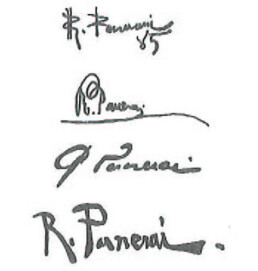
Panerai Ruggero *
PANERAI RUGGERO
Firenze 1862 – Parigi 1923
Studente dell’Accademia fiorentina di Belle Arti, dal 1880 frequentò assiduamente lo studio di G. Fattori. Esordì a Firenze nel 1883 con soggetti propri del Naturalismo toscano (Sulla via ferrata e All’ombra), ma già nel 1885 modificò il suo stile orientandosi verso espressioni di mondanità cittadina, sul genere di quelle di G. De Nittis: quell’anno eseguì II ritorno dalle corse delle Cascine e II passaggio dei cavalleggeri da piazza San Gallo (Firenze, coll. Cassa di Risparmio), caratterizzati da una vivace animazione, resa con stesura brillante e mossa, dai toni argentati. Nel 1887 ottenne importanti successi con Il cavallo malato (Firenze, Galleria d’Arte Moderna di Palazzo Pitti), tela imponente di chiara ascendenza fattoriana, esposta sia a Milano sia a Firenze, e con II guado, presentato all’Esposizione Nazionale di Venezia. Nel 1888 fu nominato professore di pittura all’Accademia di Bologna e proseguì nella realizzazione di opere ispirate alternativamente ai temi umili e solenni della vita dei campi e a brani di vita cittadina. Nel 1889 espose a Parigi un soggetto letterario, Mazzeppa (poi riproposto a Genova nel 1890), insieme a un tema militare, Difesa di una villa (grandi manovre). Con il nuovo secolo si dedicò alla pittura di genere in costume settecentesco.
